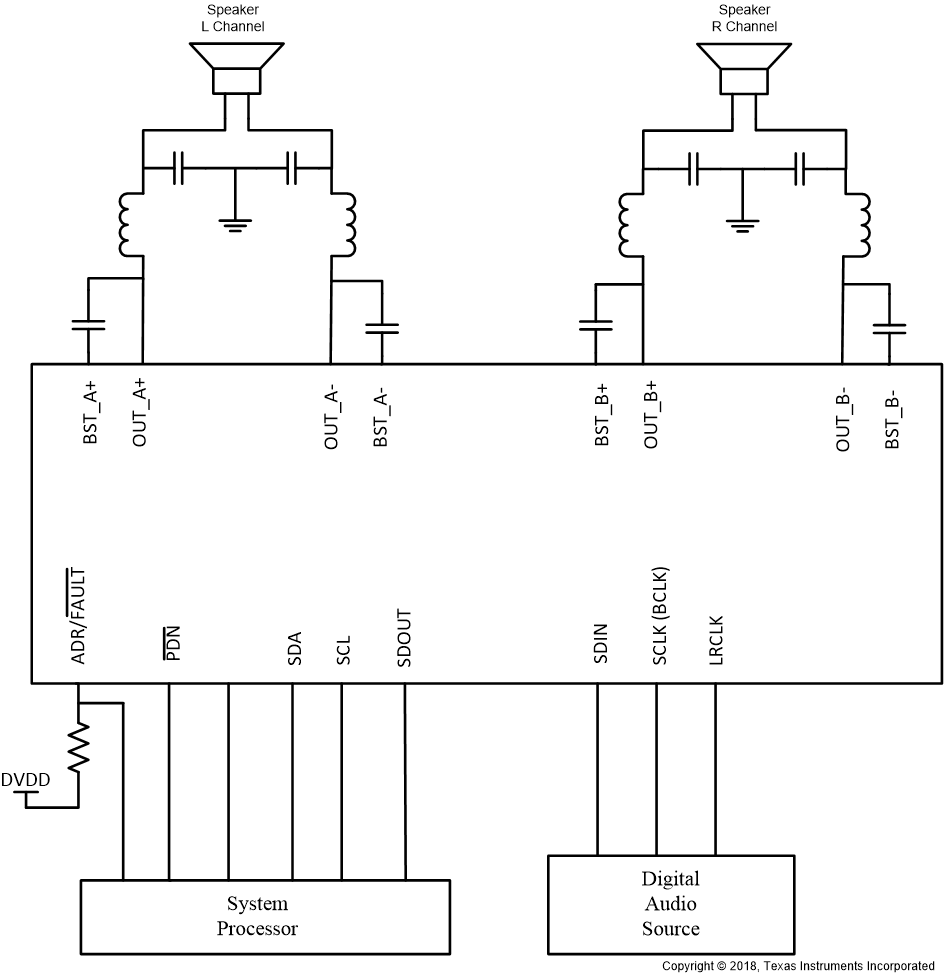ZHCSI92D May 2018 – November 2020 TAS5805M
PRODUCTION DATA
- 1 特性
- 2 应用
- 3 说明
- 4 Revision History
- 5 Device Comparison Table
- 5 Pin Configuration and Functions
-
6 Specifications
- 6.1 Absolute Maximum Ratings
- 6.2 ESD Ratings
- 6.3 Recommended Operating Conditions
- 6.4 Thermal Information
- 6.5 Electrical Characteristics
- 6.6 Timing Requirements
- 6.7
Typical Characteristics
- 6.7.1 Bridge Tied Load (BTL) Configuration Curves with 1SPW Mode
- 6.7.2 Bridge Tied Load (BTL) Configuration Curves with BD Mode
- 6.7.3 Bridge Tied Load (BTL) Configuration Curves with Ferrite Bead + Capacitor as the Output Filter
- 6.7.4 Parallel Bridge Tied Load (PBTL) Configuration with 1SPW Modulation
- 6.7.5 Parallel Bridge Tied Load (PBTL) Configuration with BD Modulation
- 7 Parameter Measurement Information
-
7 Detailed Description
- 7.1 Overview
- 7.2 Functional Block Diagram
- 7.3 Feature Description
- 7.4 Device Functional Modes
- 7.5 Programming and Control
- 7.6 Register Maps
- 8 Application and Implementation
- 9 Power Supply Recommendations
- 9 Layout
- 10Device and Documentation Support
- 11Mechanical, Packaging, and Orderable Information
封装选项
请参考 PDF 数据表获取器件具体的封装图。
机械数据 (封装 | 引脚)
- PWP|28
散热焊盘机械数据 (封装 | 引脚)
- PWP|28
订购信息
3 说明
TAS5805M 是一款高效立体声闭环 D 类放大器,可提供具有低功率耗散和丰富声音的低成本数字输入解决方案。该器件的集成音频处理器和 96kHz 架构支持高级音频处理流程(包括 SRC、每通道 15 个 BQ、音量控制、音频混合、3 频带 4 阶 DRC、全频带 AGL、THD 管理器和电平计)。
TAS5805M 采用 TI 的专有混合调制方案,消耗超低的静态电流(13.5V PVDD 下为 16.5mA),从而能够延长便携式音频应用中的电池寿命。凭借先进的 EMI 抑制技术,设计人员可以利用廉价的铁氧体磁珠滤波器来减小布板空间并降低系统成本。
器件信息
| 器件型号 | 封装(1) | 封装尺寸(标称值) |
|---|---|---|
| TAS5805M | TSSOP (28) PWP | 9.7mm × 4.4mm |
(1) 如需了解所有可用封装,请参阅米6体育平台手机版_好二三四说明书末尾的可订购米6体育平台手机版_好二三四附录。
 简化版方框图
简化版方框图